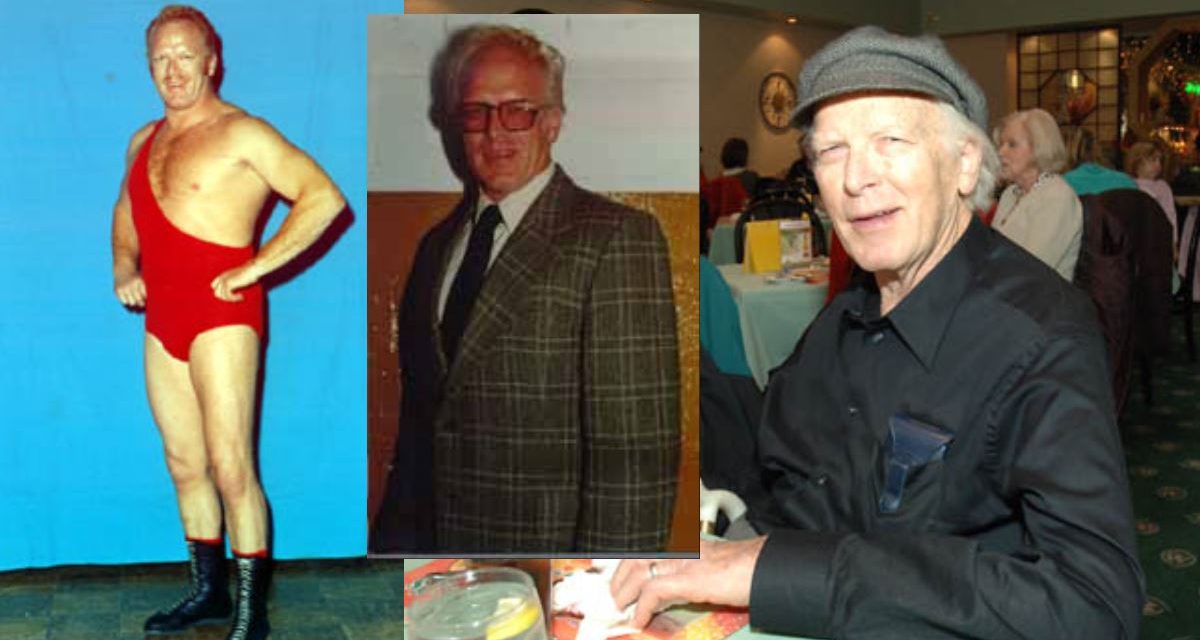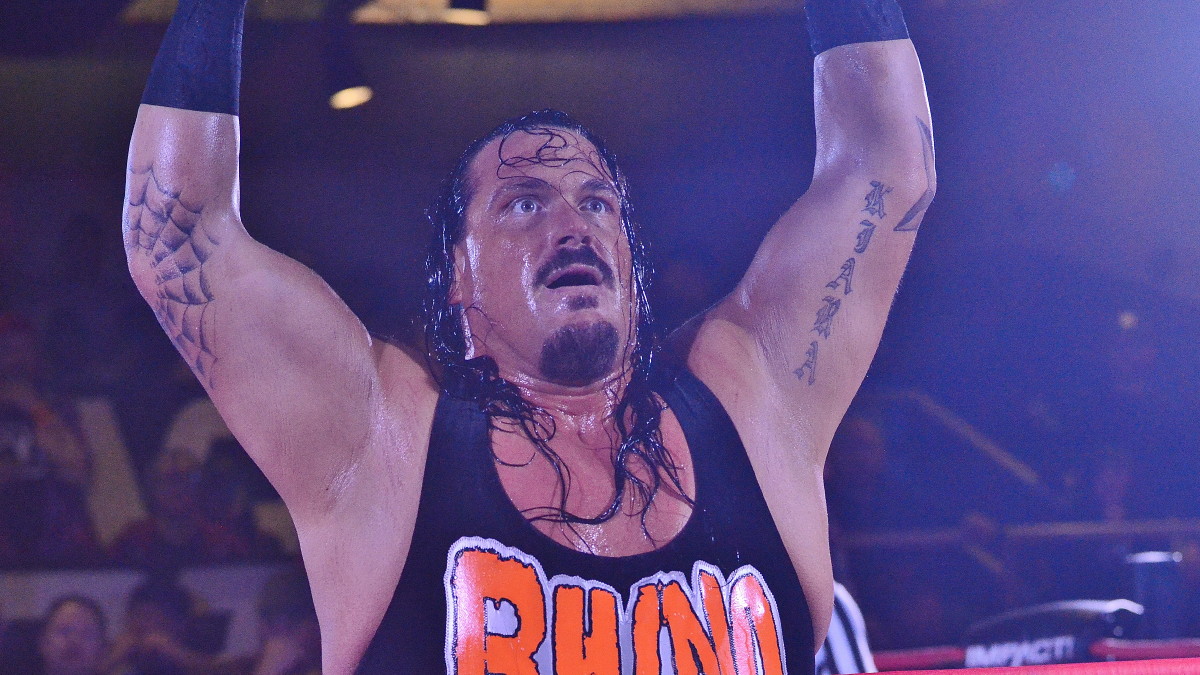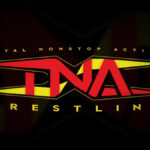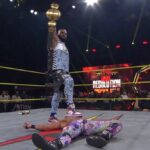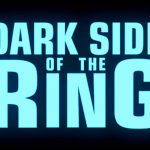It is quickly evident that Billy Red Lyons was one of those few wrestlers out there that no one has anything bad to say about. And it’s not just because he lost his battle to bone cancer on Monday. No, it’s more about the respect a wrestler has for talent, and Lyons had that in abundance.
“Cowboy” Bill Watts met Lyons in Verne Gagne’s AWA, where he was aligned with the Flying Redheads — Lyons and Red Bastien — on the side of good.
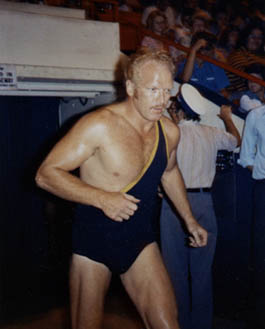
Billy Red Lyons heads to the ring. Photo by Steven Johnson
“They had a big angle going against the Vachon brothers,” Watts recalled. “Billy went out there and set the heat every friggin’ night. It wasn’t about Billy. Red was more of a spectacular guy than Billy. So Billy went out and set the heat every night, and I mean when you’re setting the heat for the Vachons, it’s a long, hard, enduring deal. They would just hammer, hammer, and hammer on you. Billy would set it, set it, set it, until it was right for the tag to Red.”
One of those Vachons doing the pounding, Mad Dog Vachon, called the Redheads “incredible athletes. It was unbelievable the matches we had against these two guys. Really great matches.”
In The Pro Wrestling Hall of Fame: The Tag Teams, Bastien said he’d found the right partner in Lyons. “I’ll tell you, we were perfect for each other,” Bastien said. In the combination, Lyons was the seasoned mat worker, while Bastien was the high flyer with the dropkicks and his trademark flying head scissors. “His timing was excellent,” Bastien said. “He was always there at the right place at the right team, and that’s what I needed.” Though the Flying Redheads were never AWA World tag team champions, they did win the Texas title from the Alaskans in 1972.
Blackjack Mulligan gave the duo the ultimate praise. “There was no greater than Red Bastien and Red Lyons. They were the greatest team of all time. There is no other team. If you ever saw Red Lyons and Red Bastien wrestle the Vachons, wrestle anybody, you had pure tag team wrestling at its basic. There’s no better, there never will be. They set the bar so high that all we could ever do is to try to achieve a small degree of their success. They were, without a doubt, a great, great team.”
Watts explained that Lyons wasn’t in the business just for himself, but knew when to give and when to take. “In any team thing, you have to have a person who is stronger and a person who is weaker to recognize their roles. That’s really, really important, because everybody has their role, and if each of you try to stay even with each other, then there’s never anything accomplished in the match and you cannot get the match over. Well, Billy Red never had that problem. He always understood where he was and he understood his role.”
But Sweet Daddy Siki said that Lyons could dish it out if he wanted to. “He’d throw you in the rope, and hit you with that damn elbow! He’d just about knock your head off. I’m serious!” Siki chortled at the memory. “My God, he’d throw you in there, hit you with the elbow, and he’d laugh about it.”
Fellow Hamiltonian Johnny Powers said Lyons had a common touch. “He looked like regular people. He wasn’t overly muscular. He was loose-goosey,” said Powers, launching into a booker/promoter analysis. “He filled a gap where there was not a gap. In other words, he wasn’t a hard, muscular babyface. He wasn’t a dynamic babyface. But he could work with anybody. He could probably work with a used broom and make a match. He could fit with anybody’s style. He was handsome. He’d move up the food chain into main events. I don’t think he dominated a territory, or could carry a territory, but he sure could compliment a territory.”
The promoter Watts saw the same thing. “From the time I saw him, at a different time in his career, there may have been guys who were bigger stars or could draw more money, Billy was always good to have in the mix. I think a lot of guys underestimate how important it is to have that guy who will make the match.”
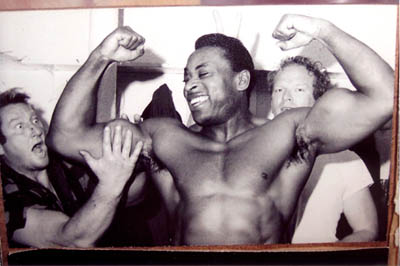
Sailor Art Thomas flexes for an astonished Yukon Eric and Billy Red Lyons in a Hamilton dressing room. Photo by Roger Baker.
Duncan McTavish knew Billy Snip when he was just a kid as well, breaking into the business in Hamilton. “He worked out at Spittles’, I worked out at Jack Wentworth’s and the Jewish Community Centre was another place guys worked out. We kind of rotated around,” said McTavish, explaining Lyons’ role. “He was always upbeat. He was a leader. Even when he was in the tag team with Dewey [Robertson, in the Crusaders], he was the one leading the match. He knew exactly what he was doing.”
Lyons was a leader in the dressing room as well. Tom Hankins, who worked as Crazy Charlie Reid, debuted in March 1973, and was invited to St. Louis, where promoter Sam Muchnick needed cannon fodder for the TV show, Wrestling at the Chase. “I got to the Chase Hotel early, thinking that I would be the first wrestler to show up, but Billy was already there and greeted me as warmly was if he’d known me for years,” Hankins said. “I was just a young, green punk, but Billy took it upon himself to introduce me to every other wrestler who came in, and that list of wrestlers was like a living Hall Of Fame, to me. In came Jack Brisco, Pat O’Connor, Hans Schmidt, Bill Miller, Harley Race, Danny Hodge, Ron Fuller and many more. Billy injured his back in his first match of the day, working with Hans Schmidt. I helped Billy sit down and I knew that he was in real pain. Billy gutted it out and worked again that day, and once he was in the ring there was no evidence of his back pain. I believe he was working with Mikel Scicluna in that match and Billy carried it to a match worthy of the high benchmark of St Louis wrestling that everyone loved and demanded. Now Billy was in even worse pain and I even had to help him put his street clothes on. He didn’t complain about the pain once and he was still just as gracious as he had been when I first met him earlier that day.”
Tom Jones was paired with Lyons in a successful tag team in Oklahoma, Louisiana and Mississippi, that held multiple titles. “Best partner I ever had,” Jones said of Lyons. “He taught me the psychology of the business, the wrestling, the moves, whatever, the bad people you couldn’t trust, who you could and couldn’t trust … We held the tag team titles longer than anybody here for Bill Watts. We had them for two years.”
All the aforementioned strengths for Lyons parlayed into his second career as an announcer, said Powers. “He was a good announcer. Better than that, he was just an all-around good guy. He never hassled anybody, never hassled the wrestlers, never hassled the promoter. Just was a good guy,” he said. “He was a good mic guy too because he didn’t try to upstage you. Lord Athol Layton wanted to be a star, just like Vince [McMahon] Jr. wanted to be a star. ‘I’m an announcer, but I’m only an announcer because I’m not going to step in the ring anymore.’ Layton, right. Billy Red just backed off and let you do your schtick. In that way, he was not only a dynamic announcer, but he was very effective announcer to get the boys over.”
And, in the end, wrestling is about getting over, and Lyons will forever be over with those who knew him.
NOTE: There will be a visitation for Billy Red Lyons on Friday from 2-4 and 7-9 p.m. and on Saturday from 12:30 to 1:15 p.m. at the Henry Walser Funeral Home , 507 Frederick St., Kitchener, 519-749-8467. Funeral service 1:30 p.m. on Saturday, June 27, 2009, in the chapel of the funeral home followed by a reception. As expressions of sympathy donations to Canadian Cancer Society would be appreciated by the family (cards available at the funeral home). www.henrywalser.com
BILLY RED LYONS STORIES
